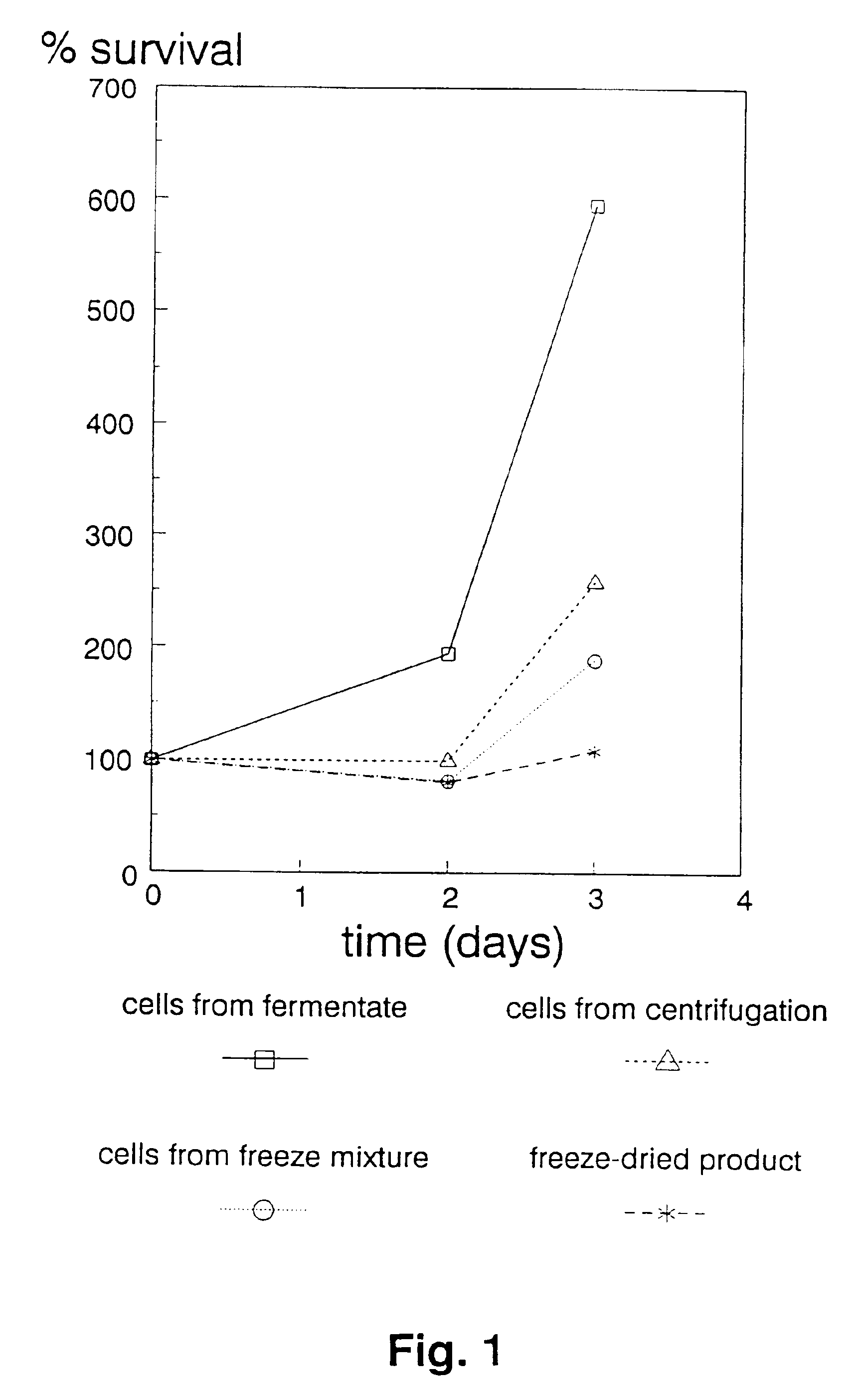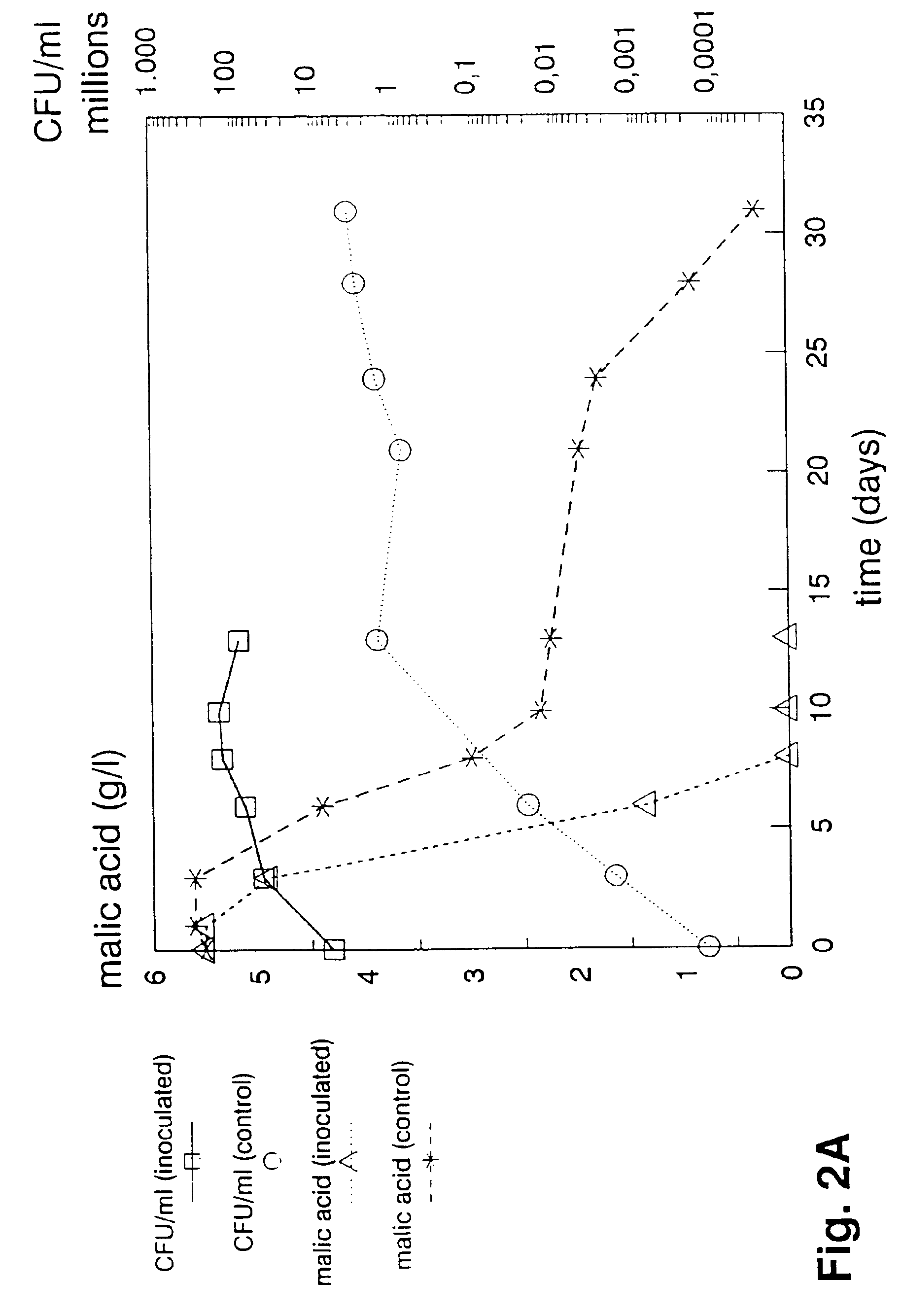Method of inducing malolactic fermentation in wine or fruit juice by direct inoculation with a non-activated started culture
a malolactic fermentation and started culture technology, applied in the field of direct inoculation of malolactic fermentation in wine or fruit juice by non-activated started culture, can solve the problems of malic acid being considered undesirable, malolactic fermentation often delayed, and the number of bacteria being often quite small, so as to avoid tedious and costly processes and effective malolactic fermentation
- Summary
- Abstract
- Description
- Claims
- Application Information
AI Technical Summary
Benefits of technology
Problems solved by technology
Method used
Image
Examples
example 1
Survival and Grown of Ln. oenos in an Experimental Wine
[0099]An experimental wine was prepared by yeasting a sterile Reisling grape juice originating from Germany, without the addition of sulphite. After completion of the alcoholic fermentation, the wine was sterile filtered and the resulting wine had the following composition:
[0100]
Ethanol11.5 vol %Malic acid 3.9 g / lResidual sugar 3.5 g / lpH 3.15
[0101]A culture of Ln. oenos strain DSM 7008 (LOD 890004) was prepared as described below, and the sterile wine was inoculated with (1) cells of the strain directly from the fermentate (i.e. the growth medium containing an outgrown culture of the strain), (2) a cell concentrate after centrifugation, (3) a cell concentrate to which cryoprotective agents had been added or (4) a freeze-dried composition of a cell concentrate with added cryoprotectants, respectively. The numbers of CFUs which were inoculated by the four mentioned forms of the strain varied between 3×106 and 7×106 per ml of the e...
example 2
Induction of Malolactic Fermentation in Red Wines and White Wines by Direct Inoculation with Ln. oenos—containing Compositions
[0104]The malolactic effect of freeze-dried compositions of two strains of Ln. oenos, DSM 7008 and DSM 7015 were tested by direct inoculation into different wines. The study was carried out by inoculating wines in 5 l jars and in industrial scale by inoculating wines contained in 5.000 to 10.000 l tanks. The inoculum level was about 5×106 per ml of wine.
[0105]The study comprised the following experiments:[0106]1. Inoculation with strain DSM 7008 of Chénin white wine from the Loire region contained in 5 l jars.[0107]2. Inoculation with strains DSM 7008 and DSM 7015 of Cabernet Sauvignon red wine from Graves in the Bordeaux region, kept in 5 l jars and additionally with DSM 7008 in a 10.000 l tank.[0108]3. Inoculation with strains DSM 7008 and DSM 7015 of Cabernet Sauvignon red wine from Premières Côtes de Bordeaux contained in 5 l jars and additionally with st...
example 3
The Effect of Propagation Conditions on the Viability of Ln. oenos Used for Inoculation into an Experimental Wine
3.1. Isolation of Test Strains
[0112]Cultures of 50 strains isolated from Spanish wines were inoculated into a 1 l fermenter containing a sterile filtered wine having initially a pH of 3.5 and an ethanol content of 11.5% (v / v). The fermenter was operated under constant stirring using a magnetic stirring at 200 rpm at a temperature of 18° C. The biomass in the fermenter was kept constant at an OD600 of about 0.10 by means of a photometer which controlled the addition of an experimental wine, described in Example 1. For this purpose the experimental wine was enriched with 0.5 g yeast extract (Oxoid) per l and the ethanol concentration and the pH of the wine were adjusted with 96% (v / v) ethanol and 2 N HCl / NaOH, respectively, to stepwise decrease the pH. The turbidostate was supplied with a total of 16 l of yeast enriched experimental wine in 4 sequential batches with the fol...
PUM
| Property | Measurement | Unit |
|---|---|---|
| concentration | aaaaa | aaaaa |
| temperature | aaaaa | aaaaa |
| pH | aaaaa | aaaaa |
Abstract
Description
Claims
Application Information
 Login to View More
Login to View More - R&D
- Intellectual Property
- Life Sciences
- Materials
- Tech Scout
- Unparalleled Data Quality
- Higher Quality Content
- 60% Fewer Hallucinations
Browse by: Latest US Patents, China's latest patents, Technical Efficacy Thesaurus, Application Domain, Technology Topic, Popular Technical Reports.
© 2025 PatSnap. All rights reserved.Legal|Privacy policy|Modern Slavery Act Transparency Statement|Sitemap|About US| Contact US: help@patsnap.com



